Helen Ngo
Nemotron-H: A Family of Accurate and Efficient Hybrid Mamba-Transformer Models
Apr 10, 2025Abstract:As inference-time scaling becomes critical for enhanced reasoning capabilities, it is increasingly becoming important to build models that are efficient to infer. We introduce Nemotron-H, a family of 8B and 56B/47B hybrid Mamba-Transformer models designed to reduce inference cost for a given accuracy level. To achieve this goal, we replace the majority of self-attention layers in the common Transformer model architecture with Mamba layers that perform constant computation and require constant memory per generated token. We show that Nemotron-H models offer either better or on-par accuracy compared to other similarly-sized state-of-the-art open-sourced Transformer models (e.g., Qwen-2.5-7B/72B and Llama-3.1-8B/70B), while being up to 3$\times$ faster at inference. To further increase inference speed and reduce the memory required at inference time, we created Nemotron-H-47B-Base from the 56B model using a new compression via pruning and distillation technique called MiniPuzzle. Nemotron-H-47B-Base achieves similar accuracy to the 56B model, but is 20% faster to infer. In addition, we introduce an FP8-based training recipe and show that it can achieve on par results with BF16-based training. This recipe is used to train the 56B model. All Nemotron-H models will be released, with support in Hugging Face, NeMo, and Megatron-LM.
Artificial Intelligence Index Report 2023
Oct 05, 2023Abstract:Welcome to the sixth edition of the AI Index Report. This year, the report introduces more original data than any previous edition, including a new chapter on AI public opinion, a more thorough technical performance chapter, original analysis about large language and multimodal models, detailed trends in global AI legislation records, a study of the environmental impact of AI systems, and more. The AI Index Report tracks, collates, distills, and visualizes data related to artificial intelligence. Our mission is to provide unbiased, rigorously vetted, broadly sourced data in order for policymakers, researchers, executives, journalists, and the general public to develop a more thorough and nuanced understanding of the complex field of AI. The report aims to be the world's most credible and authoritative source for data and insights about AI.
Evaluate & Evaluation on the Hub: Better Best Practices for Data and Model Measurements
Oct 06, 2022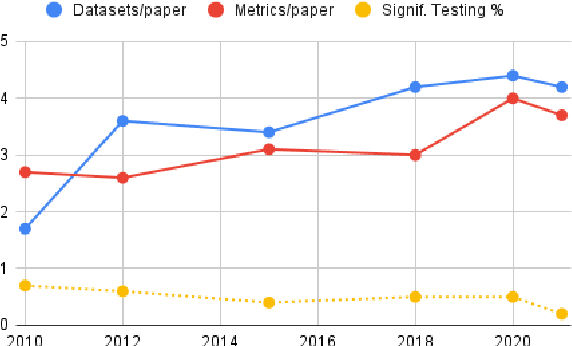
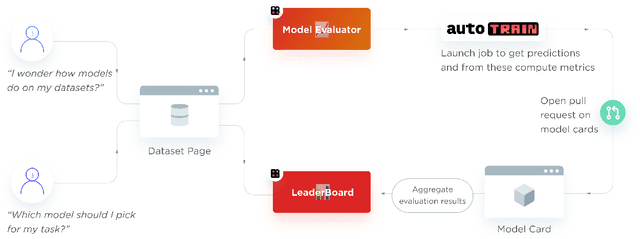
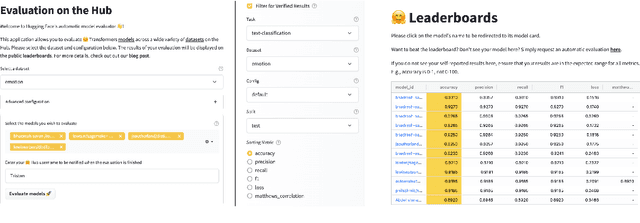
Abstract:Evaluation is a key part of machine learning (ML), yet there is a lack of support and tooling to enable its informed and systematic practice. We introduce Evaluate and Evaluation on the Hub --a set of tools to facilitate the evaluation of models and datasets in ML. Evaluate is a library to support best practices for measurements, metrics, and comparisons of data and models. Its goal is to support reproducibility of evaluation, centralize and document the evaluation process, and broaden evaluation to cover more facets of model performance. It includes over 50 efficient canonical implementations for a variety of domains and scenarios, interactive documentation, and the ability to easily share implementations and outcomes. The library is available at https://github.com/huggingface/evaluate. In addition, we introduce Evaluation on the Hub, a platform that enables the large-scale evaluation of over 75,000 models and 11,000 datasets on the Hugging Face Hub, for free, at the click of a button. Evaluation on the Hub is available at https://huggingface.co/autoevaluate.
The AI Index 2022 Annual Report
May 02, 2022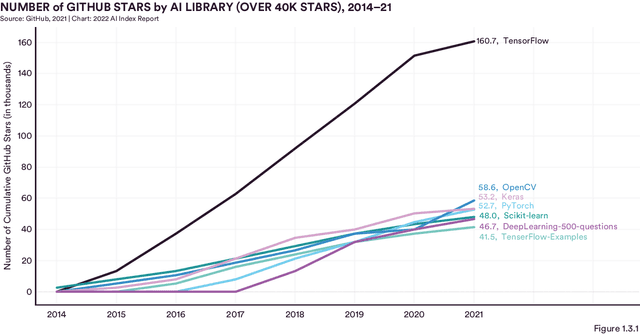
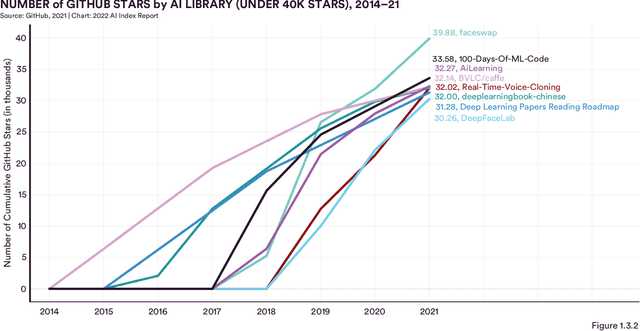
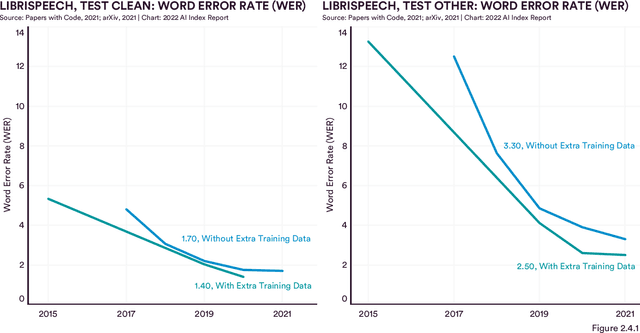
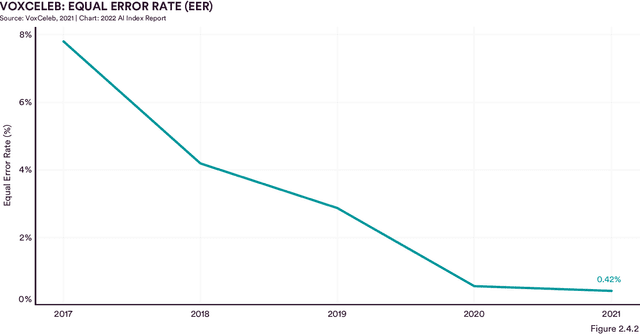
Abstract:Welcome to the fifth edition of the AI Index Report! The latest edition includes data from a broad set of academic, private, and nonprofit organizations as well as more self-collected data and original analysis than any previous editions, including an expanded technical performance chapter, a new survey of robotics researchers around the world, data on global AI legislation records in 25 countries, and a new chapter with an in-depth analysis of technical AI ethics metrics. The AI Index Report tracks, collates, distills, and visualizes data related to artificial intelligence. Its mission is to provide unbiased, rigorously vetted, and globally sourced data for policymakers, researchers, executives, journalists, and the general public to develop a more thorough and nuanced understanding of the complex field of AI. The report aims to be the world's most credible and authoritative source for data and insights about AI.
No News is Good News: A Critique of the One Billion Word Benchmark
Oct 25, 2021

Abstract:The One Billion Word Benchmark is a dataset derived from the WMT 2011 News Crawl, commonly used to measure language modeling ability in natural language processing. We train models solely on Common Crawl web scrapes partitioned by year, and demonstrate that they perform worse on this task over time due to distributional shift. Analysis of this corpus reveals that it contains several examples of harmful text, as well as outdated references to current events. We suggest that the temporal nature of news and its distribution shift over time makes it poorly suited for measuring language modeling ability, and discuss potential impact and considerations for researchers building language models and evaluation datasets.
Mitigating harm in language models with conditional-likelihood filtration
Sep 04, 2021



Abstract:Language models trained on large-scale unfiltered datasets curated from the open web acquire systemic biases, prejudices, and harmful views from their training data. We present a methodology for programmatically identifying and removing harmful text from web-scale datasets. A pretrained language model is used to calculate the log-likelihood of researcher-written trigger phrases conditioned on a specific document, which is used to identify and filter documents from the dataset. We demonstrate that models trained on this filtered dataset exhibit lower propensity to generate harmful text, with a marginal decrease in performance on standard language modeling benchmarks compared to unfiltered baselines. We provide a partial explanation for this performance gap by surfacing examples of hate speech and other undesirable content from standard language modeling benchmarks. Finally, we discuss the generalization of this method and how trigger phrases which reflect specific values can be used by researchers to build language models which are more closely aligned with their values.
 Add to Chrome
Add to Chrome Add to Firefox
Add to Firefox Add to Edge
Add to Edge